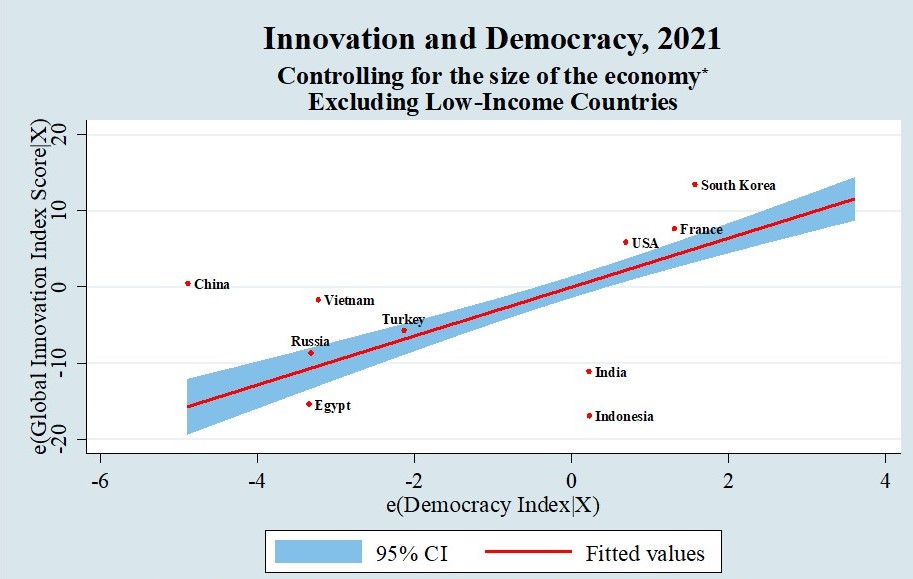Innovation drives economic growth, however data indicates innovative capability differs across economies. Simon Commander, Saul Estrin and Thamashi De Silva suggest democracy is associated with more innovation overall, though different political systems also produce different forms of innovation.
Innovation, whether of products or processes, is, of course, essential in driving economic growth, particularly in economies where extensive growth through the accumulation of capital and labour is no longer feasible. It is also clear that there are large differences in innovative capability across economies. This blog asks whether some of these differences can be explained by the variation in political systems?
To explore this further, we use several datasets. The first dataset is the Economist Intelligence Unit’s (EIU) Democracy Index. This gives a score ranging from 0-10, where 0-4 are categorized as authoritarian regimes, 4.01-6 are hybrid regimes, 6.01-8 are flawed democracies and 8.01-10 are full democracies. The second is a measure of innovation – the Global Innovation Index (GII) – which places countries on a scale from 0 (least innovative) to 100 (most innovative).
Figure 1. Innovation and Democracy, 2021
Notes: We used 2020 GDP data, which is the latest available data. Number of countries: 117. In Figures 1, 2 and 5, we plot the dependent variable against the independent variable, while controlling for the size of the economy. Therefore, the plotted values in these three figures do not directly translate to the actual value of the independent/dependent variable.
Sources: The Economist Intelligence Unit (EIU), World Development Indicators (WDI) and World Intellectual Property Organisation (WIPO).
Figure 1 now plots the GII score against the Democracy Index using data for 117 countries for 2021, controlling for the size of the economy. It also excludes low-income countries where little innovation could be expected (low-income defined by the World Bank as a gross national income per capita of $1035 or less in 2019). The plot gives an upward sloping line (along with a shaded area that provides the 95 per cent confidence interval) suggesting that a country’s innovation score is higher when the political system is democratic. Non-democratic countries have materially lower innovation scores. Note, similar results are obtained when we use other democracy measures, such as V-Dem.
Figure 1 also shows where five major democracies and authoritarian regimes (autocracies) lie. South Korea, France and the USA all lie significantly above the fitted line, most notably South Korea. These countries innovate more than might be expected for their economic size, even among democracies. However, other less rich democracies, such as India and Indonesia, do not score well in terms of innovation. For the autocracies, most sit around the fitted line – although China and Vietnam lie significantly above that line. In short, while there is clear variation within these broad political categories, in this large sample of countries it is evident that being democratic is associated with more innovation.
Figure 2. Patents and Democracy, 2020
Notes: Number of countries: 77.
Sources: The Economist Intelligence Unit (EIU), World Development Indicators (WDI) and World Intellectual Property Organisation (WIPO).
Figure 2 now looks at how one important indicator of innovation – the number of resident patent applications per million of population – is associated with the political system. The data are for 77 countries, and the regression, again controls for the size of the economy and excludes low-income countries (for 2020, those with GNI per capita of $1025 or less in 2018). Once again, the figure displays a clearly upward sloping line, with greater democracy being associated with more patenting. In this instance, we select only 9 countries, because South Korea is a massive outlier with very high amounts of patenting. China sits above the confidence interval and India below.
Another important way to measure innovation is through inputs, indicated by expenditure on Research and Development (R&D). There is a mountain of evidence that R&D is essential for innovation. In most advanced (and democratic) economies, governments structure their tax systems in ways that are meant to stimulate R&D – such as using tax credits. In general, it is expected that private businesses will execute the bulk of that R&D because they are consumer facing and it is to consumers that the bulk of innovation is directed.
Figure 3. Business-Financed GERD and Democracy, 2019
Notes: Number of countries: 34.
Sources: The Economist Intelligence Unit (EIU) and the Organisation for Economic Co-operation and Development (OECD).
Building on this, Figure 3 plots business-financed gross domestic expenditure on R&D (GERD) as a percentage of gross domestic product (GDP) against the political system. In this instance, data limits us to 34 countries covered by the OECD. Once again, there is a clear, upward sloping line. The data limitations also mean that we can only include three countries by each type of political system. Among the democracies, both the USA and South Korea have far higher levels of business-financed GERD, as does China among the autocracies. In fact, China and the USA have nearly comparable shares of business-financed R&D.
Figure 4. Government-Financed GERD and Democracy, 2019
Notes: Number of countries: 34.
Sources: The Economist Intelligence Unit (EIU) and the Organisation for Economic Co-operation and Development (OECD).
Figure 4 flips the argument and looks at whether Government funded R&D (GERD) bears any association with the political system. It appears that such spending tends to be higher in democracies. Once again, South Korea lies way above the line. There is also one massive outlier among the autocracies. Russia has exceptionally high levels of government funded R&D. Some of that is surely military, but some of it is simply a function of resources allocated to public laboratories or universities by the state. Of course, the plot says nothing about the effectiveness of such spending. However, these two figures suggest that there are likely to be important complementarities between public and private R&D. It is by no means a simple story of one necessarily crowding out the other.
Our figures suggest that democracy is associated with more innovation overall, as well as greater patenting. However, it may well be that different political systems generate different types of innovation. An obvious example is Russia. Drawing on its Soviet legacy, the country has advanced weaponry, including hypersonic missiles. It also appears that China has been able to develop highly advanced weapons systems and space exploration capacity, among other types of innovation. This seems to be true even though there is far less evidence of innovation in the broader economy, especially in the Russian case.
Figure 5. Military Expenditure and Democracy, 2020
Notes: Military Expenditure data for Vietnam is from 2018. Number of Countries: 119.
Sources: The Economist Intelligence Unit (EIU) and World Development Indicators (WDI).
Taking these ideas further, Figure 5 plots military expenditure as a share of GDP against the political system score. Again, the figure controls for the size of the economy and excludes low-income countries. Military expenditures as a share of the economy are much lower in democracies. For the individual countries, Russia is a striking outlier as it lies well above the line, as does the USA. South Korea and India – both with neighbours (North Korea and Pakistan respectively) with whom they have historically been in conflict – also have relatively high military expenditures.
What should we conclude? A country’s political system exerts a powerful influence on the extent of innovation. Democracies are clearly more supportive of innovation than autocracies. It is not hard to think of why. Innovation often challenges the way that things are being done. It relies on the free and open exchange of ideas, concepts and arguments. It flourishes in environments supportive of risk-taking and creativity. It takes root through experimentation and an acceptance of trial and error. None of these attributes come easily to autocracies.
Further, the political system affects not only the amount of innovation but also its form. A brief glance at the history of the Soviet Union, as well as Russia and China more recently, shows that they have been able to innovate. But innovation for the benefit of society and the consumer is relatively muted. Autocracies innovate and create technologies mostly under the auspices of the government and, often – as in Russia – through the military. Mariana Mazzucato has rightly argued that government funded research is not inherently bad and may well generate major spillovers, and hence benefits, for the broader economy. In the hands of autocrats, innovation is far more likely to lack such dynamic interaction, due to a focus on military aims such as potential aggression abroad, and/or suppression of citizens at home. As such, this sort of innovation yields few, if any, wider social benefits for the population.
♣♣♣
Notes:
- This blog post expresses the views of its author(s), not the position of LSE Business Review or the London School of Economics.
- Featured Image by Rob Lambert on Unsplash
- When you leave a comment, you’re agreeing to our Comment Policy.










